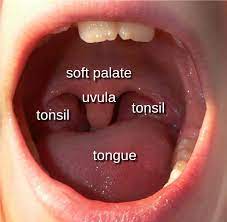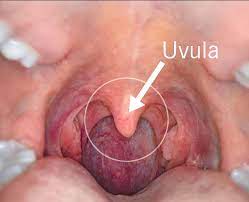
 The uvula also known as the palatine uvula, is a conic projection from the back edge of the middle of the soft palate, composed of connective tissue containing a number of racemose glands, and some muscular fibers.
The uvula also known as the palatine uvula, is a conic projection from the back edge of the middle of the soft palate, composed of connective tissue containing a number of racemose glands, and some muscular fibers.
It also contains many serous glands, which produce thin saliva.
The muscular part of the uvula can shorten and broaden the uvula, changing the contour of the posterior part of the soft palate allowing the soft palate to adapt closely to the posterior pharyngeal wall to help close the nasopharynx during swallowing.
Its muscles are controlled by the pharyngeal branch of the vagus nerve.
A bifid or bifurcated uvula is a split or cleft uvula.
Newborns with cleft palate often also have a split uvula.
The bifid uvula results from incomplete fusion of the palatine shelves.
Bifid uvulas have less muscle in them than a normal uvula, which may cause recurring problems with middle ear infections.
The soft palate is pushed backwards during swallowing, preventing food and drink from entering the nasal cavity.
If the soft palate cannot touch the back of the throat while swallowing, food and drink can enter the nasal cavity.
Bifid uvula occurs in about 2% of the general population.
Some populations may have a high incidence of Brigid uvula: Native Americans who have a 10% rate.
Bifid uvula is a common symptom of the rare Loeys–Dietz syndrome, which is associated with an increased risk of aortic aneurysm.
During swallowing, the soft palate and the uvula move together to close off the nasopharynx, and prevent food from entering the nasal cavity.
It is proposed that the abundant amount of thin saliva produced by the uvula serves to keep the throat well lubricated.
Consonant sounds, known as uvular consonants, are articulated by creating a constriction of airflow between the uvula and the back of the tongue.
The voiced uvular trill, is used in French, Arabic and Hebrew, among other languages.
There is a large of saliva produced from glands in the uvula that suggest it is an accessory speech organ.
Stimulation of the uvula also causes the gag reflex to initiate, and a common method of inducing vomiting.
A swollen uvula, causing the uvula to expand 3–5 times its normal size is known as uvulitis.
When the uvula touches the throat or tongue, it can cause sensations like gagging or choking.
A swollen uvula can cause problems with breathing, talking, and eating.
Causes the uvula to swell include: dehydration, excessive smoking or other inhaled irritants; snoring; allergic reaction; or a viral or bacterial infection.
The uvula can lead to snoring or heavy breathing during sleep.
The elongation of the uvula can cause vibrations that lead to snoring.
Obstructive sleep apnea associated with the uvula can be treated by
uvulopalatopharyngoplasty.
If the uvula does not close properly against the back of the throat, it can cause veloopharyngeal insufficiency causing “nasal/hyper-nasal” speech, where extra air comes down the nose, and the speaker is unable to say certain consonants, such as pronouncing ‘b’ like ‘m’.
With swallowing, the soft palate and the uvula move superiorly to close off the nasopharynx, preventing food from entering the nasal cavity.
If this process fails, the result is called nasal regurgitation.
It is common in people with velopharyngeal insufficiency, the myositides, and neuromuscular disease.
Nasal regurgitation of fluids in this way may also occur if a particularly high volume of liquid is regurgitated, or during vigorous coughing being caused by the accidental inhalation of water.
Coughing may prevent the uvula from blocking the nasopharynx, liquid may be expelled back through the nose.
